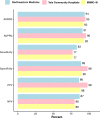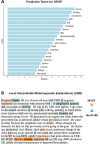This is a preprint.
Automated Identification of Heart Failure with Reduced Ejection Fraction using Deep Learning-based Natural Language Processing
- PMID: 37745445
- PMCID: PMC10516088
- DOI: 10.1101/2023.09.10.23295315
Automated Identification of Heart Failure with Reduced Ejection Fraction using Deep Learning-based Natural Language Processing
Update in
-
Automated Identification of Heart Failure With Reduced Ejection Fraction Using Deep Learning-Based Natural Language Processing.JACC Heart Fail. 2025 Jan;13(1):75-87. doi: 10.1016/j.jchf.2024.08.012. Epub 2024 Oct 23. JACC Heart Fail. 2025. PMID: 39453355
Abstract
Background: The lack of automated tools for measuring care quality has limited the implementation of a national program to assess and improve guideline-directed care in heart failure with reduced ejection fraction (HFrEF). A key challenge for constructing such a tool has been an accurate, accessible approach for identifying patients with HFrEF at hospital discharge, an opportunity to evaluate and improve the quality of care.
Methods: We developed a novel deep learning-based language model for identifying patients with HFrEF from discharge summaries using a semi-supervised learning framework. For this purpose, hospitalizations with heart failure at Yale New Haven Hospital (YNHH) between 2015 to 2019 were labeled as HFrEF if the left ventricular ejection fraction was under 40% on antecedent echocardiography. The model was internally validated with model-based net reclassification improvement (NRI) assessed against chart-based diagnosis codes. We externally validated the model on discharge summaries from hospitalizations with heart failure at Northwestern Medicine, community hospitals of Yale New Haven Health in Connecticut and Rhode Island, and the publicly accessible MIMIC-III database, confirmed with chart abstraction.
Results: A total of 13,251 notes from 5,392 unique individuals (mean age 73 ± 14 years, 48% female), including 2,487 patients with HFrEF (46.1%), were used for model development (train/held-out test: 70/30%). The deep learning model achieved an area under receiving operating characteristic (AUROC) of 0.97 and an area under precision-recall curve (AUPRC) of 0.97 in detecting HFrEF on the held-out set. In external validation, the model had high performance in identifying HFrEF from discharge summaries with AUROC 0.94 and AUPRC 0.91 on 19,242 notes from Northwestern Medicine, AUROC 0.95 and AUPRC 0.96 on 139 manually abstracted notes from Yale community hospitals, and AUROC 0.91 and AUPRC 0.92 on 146 manually reviewed notes at MIMIC-III. Model-based prediction of HFrEF corresponded to an overall NRI of 60.2 ± 1.9% compared with the chart diagnosis codes (p-value < 0.001) and an increase in AUROC from 0.61 [95% CI: 060-0.63] to 0.91 [95% CI 0.90-0.92].
Conclusions: We developed and externally validated a deep learning language model that automatically identifies HFrEF from clinical notes with high precision and accuracy, representing a key element in automating quality assessment and improvement for individuals with HFrEF.
Keywords: Deep learning; Electronic heart records; Heart failure with reduced ejection fraction; Longformer; Natural language processing.
Conflict of interest statement
Disclosures Dr. Tariq Ahmad is a consultant for Sanofi-Aventis, Amgen, and Cytokinetics. He has research funding from Boehringer Ingelheim, AstraZeneca, Cytokinetics, and Relypsa. Dr. Nadkarni reports consultancy agreements with AstraZeneca, BioVie, GLG Consulting, Pensieve Health, Reata, Renalytix, Siemens Healthineers and Variant Bio; has received research funding from Goldfinch Bio, and Renalytix; has received honoraria from AstraZeneca, BioVie, Lexicon, Daiichi Sankyo, Meanrini Health, and Reata; has patents or royalties with Renalytix; owns equity and stock options in Pensieve Health and Renalytix as a scientific cofounder; owns equity in Verici Dx; has received financial compensation as a scientific board member and advisor to Renalytix; has served on the advisory board of Neurona Health; and has served in an advisory or leadership role for Pensieve Health and Renalytix. Dr. Faraz Ahmad reports grants from the Agency for Healthcare Research and Quality, grants from the National Institutes of Health/National Heart, Lung, and Blood Institute, grants from the American Heart Association, personal fees from Teladoc, personal fees from Livongo, personal fees from Pfizer, outside the submitted work. Dr. Krumholz works under contract with the Centers for Medicare & Medicaid Services to support quality measurement programs, was a recipient of a research grant from Johnson & Johnson, through Yale University, to support clinical trial data sharing; was a recipient of a research agreement, through Yale University, from the Shenzhen Center for Health Information for work to advance intelligent disease prevention and health promotion; collaborates with the National Center for Cardiovascular Diseases in Beijing; receives payment from the Arnold & Porter Law Firm for work related to the Sanofi clopidogrel litigation, from the Martin Baughman Law Firm for work related to the Cook Celect IVC filter litigation, and from the Siegfried and Jensen Law Firm for work related to Vioxx litigation; chairs a Cardiac Scientific Advisory Board for UnitedHealth; was a member of the IBM Watson Health Life Sciences Board; is a member of the Advisory Board for Element Science, the Advisory Board for Facebook, and the Physician Advisory Board for Aetna; and is the co-founder of Hugo Health, a personal health information platform, and co-founder of Refactor Health, a healthcare AI-augmented data management company. Dr. Khera is an Associate Editor of JAMA. He receives support from the National Heart, Lung, and Blood Institute of the National Institutes of Health (under award K23HL153775) and the Doris Duke Charitable Foundation (under award, 2022060). He also receives research support, through Yale, from Bristol-Myers Squibb and Novo Nordisk. He is a coinventor of U.S. Provisional Patent Applications 63/177,117, 63/428,569, 63/346,610, 63/484,426, and 3/508,315. He is a co-founder of Evidence2Health, a precision health platform. The remaining authors have no competing interests to disclose.
Figures






References
-
- Benjamin EJ, Muntner P, Alonso A et al. Heart Disease and Stroke Statistics-2019 Update: A Report From the American Heart Association. Circulation 2019;139:e56–e528. - PubMed
-
- Tromp J, Ouwerkerk W, van Veldhuisen DJ et al. A Systematic Review and Network Meta-Analysis of Pharmacological Treatment of Heart Failure With Reduced Ejection Fraction. JACC Heart Fail 2022;10:73–84. - PubMed
-
- Greene SJ, Butler J, Albert NM et al. Medical Therapy for Heart Failure With Reduced Ejection Fraction: The CHAMP-HF Registry. J Am Coll Cardiol 2018;72:351–366. - PubMed
Publication types
Grants and funding
LinkOut - more resources
Full Text Sources
